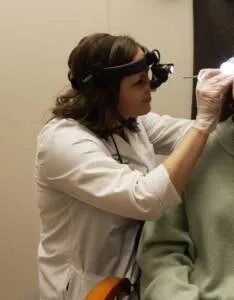Ear wax, medically known as cerumen, plays an essential role in maintaining ear health. It helps to trap dirt, dust, and other particles, preventing them from reaching the inner ear. However, many people mistakenly believe that ear wax is harmful and must be removed frequently. This misunderstanding often leads to improper ear wax removal practices that can cause more harm than good. In this article, we’ll discuss common mistakes people make when removing ear wax and how to approach ear care safely.
Mistake 1: Using Cotton Swabs Improperly
One of the most common mistakes is using cotton swabs (or Q-tips) to clean the ears. While it might feel satisfying, cotton swabs often push ear wax deeper into the ear canal instead of removing it. This can lead to blockages, discomfort, and even damage to the eardrum. Ear wax removal should never involve inserting objects into the ear canal.
Mistake 2: Overcleaning the Ears
Many people believe that ears need to be cleaned daily, but this is not true. The ears are self-cleaning organs, and excessive cleaning can disrupt this natural process. Overcleaning may remove too much ear wax, leaving the ear canal dry and more susceptible to infections. It’s important to understand that some ear wax is normal and healthy.
Mistake 3: Ignoring Signs of Ear Wax Buildup
Another common error is ignoring symptoms of ear wax buildup, such as hearing loss, ear pain, or a feeling of fullness in the ear. Instead of addressing the issue appropriately, people often resort to DIY methods that can worsen the problem. If you experience persistent symptoms, it’s time to seek professional ear wax removal services.
Mistake 4: Using Unsafe DIY Methods
From ear candling to using sharp objects, many unsafe DIY methods are still popular despite being ineffective and risky. Ear candling, for example, has no scientific basis and can cause burns or blockages. Similarly, using items like hairpins or keys to remove ear wax is dangerous and can damage the sensitive structures of the ear.
Mistake 5: Ignoring Professional Help
Some people attempt to handle serious ear wax issues on their own, even when professional assistance is needed. Ear wax removal should sometimes be left to a healthcare provider, especially if there’s significant buildup or if you have a history of ear problems. Professionals use safe and effective techniques to remove ear wax without causing harm.
Mistake 6: Misusing Over-the-Counter Products
While over-the-counter ear drops can be useful for softening ear wax, they are not always used correctly. Overusing these products or using them when they’re not needed can lead to irritation or an allergic reaction. Always read the instructions and consult a healthcare professional if you’re unsure about their use.
Mistake 7: Not Knowing When to Stop
Some people persist in trying to remove ear wax even when their ears are clear, leading to unnecessary irritation or injury. It’s crucial to recognize that ear wax is beneficial in moderation and doesn’t always need to be removed.
Safe and Effective Ear Wax Removal Tips
To avoid these common mistakes, consider the following safe practices for ear wax removal:
-
Let Your Ears Self-Clean: Ears naturally expel excess wax as part of their self-cleaning mechanism. Allow this process to happen without interference.
-
Use a Damp Cloth: For external cleaning, wipe the outer ear gently with a damp cloth. Avoid inserting anything into the ear canal.
-
Try Over-the-Counter Drops: Use ear drops to soften stubborn wax. Follow the product instructions carefully and use only as needed.
-
Irrigation: For mild blockages, warm water irrigation can be effective. However, this should be done carefully and only if there’s no history of ear issues like perforated eardrums.
-
Seek Professional Help: If you suspect ear wax buildup is affecting your hearing or causing discomfort, consult a healthcare provider. Professionals use tools like curettes or suction devices to safely remove ear wax.
-
Avoid Risky Techniques: Steer clear of methods like ear candling or inserting objects into your ears. These practices are not only ineffective but also hazardous.
When to See a Doctor
While many ear wax issues can be managed at home, there are times when professional intervention is necessary. Contact a healthcare provider if you experience:
-
Persistent ear pain
-
Hearing loss that doesn’t improve
-
Discharge from the ear
-
A history of ear infections or eardrum damage
Conclusion
Ear wax is an essential part of ear health, and improper removal practices can lead to complications. By avoiding common mistakes such as using cotton swabs, overcleaning, and attempting unsafe DIY methods, you can maintain healthy ears. Remember, ear wax removal doesn’t have to be a daily task, and professional help is always available when needed. Prioritize safe ear care to protect your hearing and overall ear health.
